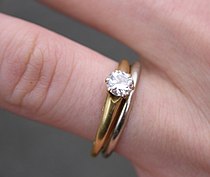There are many factors to consider before purchasing a diamond engagement ring, and one of the most practical aspects of this process is the question of financing the purchase.
The old fashioned rule stating that an engagement ring should cost three month's of a man's wages, is now a thing of the past. There's no hard and fast rule dictating what percentage of your income you will spend, though you can expect to spend at least $2,000 (with the average American engagement ring running near $4,000). For example, you can get a sophisticated three-stone engagement ring, like the ArtCarved ring at right, for $1,735. In the middle of the price spectrum lies the the gorgeous, contemporary-feeling Bella Vita engagement ring, from Mervis's Halo Collection, for a little more than $3,000. On the higher end of the price range, consider the Tacori HT from the Channel collection at around $13,000--and have her feeling regal as a queen.
For example, you can get a sophisticated three-stone engagement ring, like the ArtCarved ring at right, for $1,735. In the middle of the price spectrum lies the the gorgeous, contemporary-feeling Bella Vita engagement ring, from Mervis's Halo Collection, for a little more than $3,000. On the higher end of the price range, consider the Tacori HT from the Channel collection at around $13,000--and have her feeling regal as a queen.
So now that you've found the perfect cut and style of diamond, how can you take it home with you to surprise your sweetheart? You've got two main financing options:
Through Your Jeweler
Your first resource should be the jeweler you're buying from, so make sure to choose a well-established and respected jeweler, as well as one that has a reputation for providing quality pieces at fair prices.Stop into your local brick-and-mortar jeweler and ask about their financing options. Questions to ask:
- Does this store have any lines of credit available?
- Are you partnered with any credit card companies that are running credit lines for purchases like these?
- Are there any seasonal promotions going on right now? (Usually winter holidays and Valentine's Day give rise to such promotions.)
Through Your Bank, or Other Financial Institution
Don't be intimidated by taking out a personal loan! In the world of banking, the loan for an engagement ring is relatively small (compare it with the price of four years of college tuition or a new house).
Also keep in mind that the interest rates on personal loans tend to be less than those on credit cards. Research the terms at your current banking location, and determine if it's wiser to charge the ring on your current credit card, or to take out a personal loan.
Finally, know that your personal loan options from a bank are a secured, or an unsecured, loan. In a secured loan, you will offer the bank collateral--which they can repossess if you are unable to make loan payments. In an unsecured loan, you offer no collateral, but will pay a higher interest rate.
At Mervis Diamond Importers, we believe in forming a personal relationship with our customers. Contact us today or stop in to one of our three locations in Maryland, Washington DC, or Virginia for consultations on the style and quality of your engagement ring, as well as your options for financing this purchase. We know that this is an exciting time in your life--so let us be there for you while you take the next big step: committing to the partner you love.


 Engagements and weddings are important life milestones steeped in tradition and etiquette. One such tradition relates to the placement of wedding and engagement rings on the bride's ring finger.
Engagements and weddings are important life milestones steeped in tradition and etiquette. One such tradition relates to the placement of wedding and engagement rings on the bride's ring finger. 













